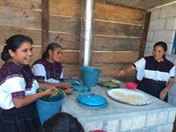Redesign of the Wood-Burning Stove
Our current focus project, IGNITING CHANGE, builds healthier, stronger communities one stove at a time by training indigenous communities to build eco-cookstoves. We have been working with communities for 4 years to develop our impactful stove & a stove builders’ social enterprise.
We studied past stoves & other cooking methods and engineered an energy-efficient, eco-cookstove (La Mazateca) and training program. They are designed to impact critical social issues in indigenous communities in Oaxaca and Chiapas:
- Deforestation
- Poor access to clean water
- Poor household health
- Lack of jobs and economic opportunities
On a household level, our stoves mean families have smoke-free and grime-free kitchens, reduced time spent collecting firewood (2 hours/day to 40 min), less tree-cutting overall, more children enrolled in school, higher employment rates (including among women), improved community clean water resources, and greater community self-reliance for future sustainability projects
Our Innovation: Our stoves are not just another cookstove venture in the region. We consider who is using our stoves, what they are cooking, and a communities’ cultural needs.
 Deforestation and Household Health: Our eco-cookstoves use 50-70% less wood than commonly used traditional stoves, reducing the labor required per day by 50% and allowing children to spend less time collecting firewood and more time in school. It also reduces the back-breaking labor for women who collect larger pieces of firewood each day.
Deforestation and Household Health: Our eco-cookstoves use 50-70% less wood than commonly used traditional stoves, reducing the labor required per day by 50% and allowing children to spend less time collecting firewood and more time in school. It also reduces the back-breaking labor for women who collect larger pieces of firewood each day.
This is the amount of wood families in Chiapas need to keep close at hand for just a few weeks of cooking. Multiply this amount of wood by the 50,000 people in the region who are expected to adopt our La Mazateca clean cookstove. That’s a lot of wood that will stay in the rainforest, and that means a lot less labor for families!
 Household health: Unlike other NGO and government-installed cookstoves, our stove is molded and allows for air flow and wood placement to occur in two different places. The castable refractory we use to shape the stove ensures the stove does not heat up on the outside to unsafe temperatures, but the pots heat up rapidly for efficient cooking. This reduces daily injuries among women and children placing wood in the stove and trying to fan air in the same place as in other models of cookstoves.
Household health: Unlike other NGO and government-installed cookstoves, our stove is molded and allows for air flow and wood placement to occur in two different places. The castable refractory we use to shape the stove ensures the stove does not heat up on the outside to unsafe temperatures, but the pots heat up rapidly for efficient cooking. This reduces daily injuries among women and children placing wood in the stove and trying to fan air in the same place as in other models of cookstoves.
Unlike other NGO and government-installed cookstoves, our stoves offer multiple places to cook so families do not need to light more than 1 open fire every morning. Our simmer pots are culturally engineered so houses can easily keep coffee warm all day long, as is their custom.
Economic opportunity: The stove builder training program we have developed in these 4 years means that our cookstove technology is transferable — with the potential to benefit the economic growth of entire communities!

A stove builders workshop
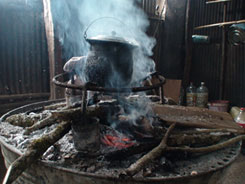 Traditional regional cookstoves (open, wood-burning flames located indoors that are the equivalent of an indoor campfire):
Traditional regional cookstoves (open, wood-burning flames located indoors that are the equivalent of an indoor campfire):
- produce enough smoke to have detrimental health effects for women and children near the kitchen.
- result in much more of the 70% intact regional rainforest being cut down overtime, endangering water resources and contributing to flooding.
- are inefficient and require more labor in firewood gathering from children who would otherwise be attending school.
- result in fewer meals per day being cooked per household because meals take 2.5 times longer
to cook.
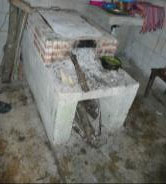
Other regional cookstoves installed by the government or in-country NGOs to improve traditional cooking methods:
- have been poorly designed & have proven dangerous for users.
- only have 1 cooking surface (SeaChar’s Biochar stove, Envirofit stoves).
- have not trained women to use or maintain cookstoves, so they were often abandoned.
- did not have a readily available supply chain to ensure repairs & lasting impact.
- did not leverage technology so families could form a business enterprise.
- have ultimately resulted in families returning to hazardous, inefficient wood-burning cooking methods.
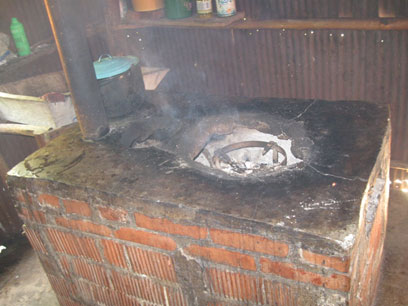
The government stove pictured above has a chimney so small in diameter that smoke backs up throughout the entire house.
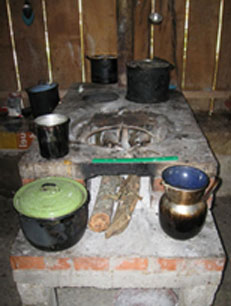
An inefficient and rapidly deteriorating government-installed stove

